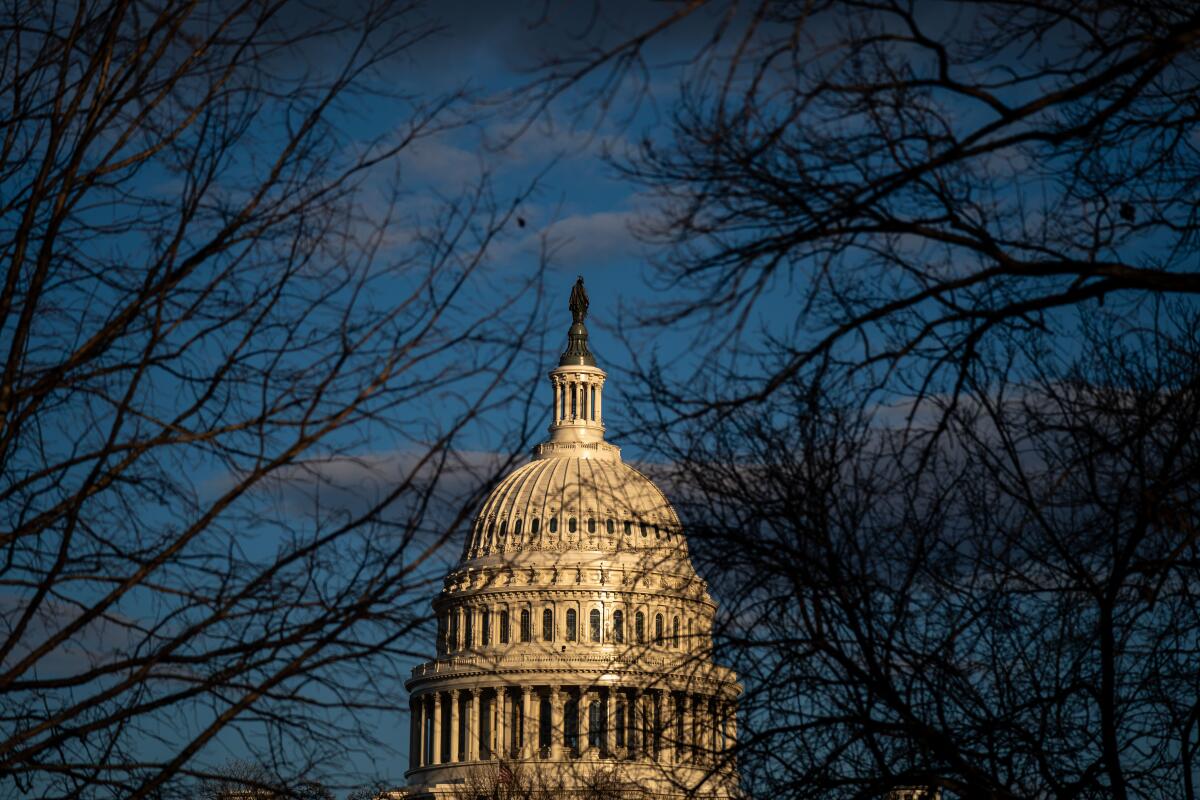California is losing a congressional seat. Which one it loses could help the GOP control the House

- Share via
SACRAMENTO — California will lose a congressional seat next year, probably one now held by a Los Angeles County Democrat. And that could help Republicans capture the House.
Republicans need a net gain of only five seats nationally to seize the House from Democrats.
Or it’s conceivable the disappearing California seat could be one currently occupied by a Republican, thus helping Democrats retain House control. The reason that isn’t likely, however, is because there aren’t that many GOP House seats in California to lose.
Democrats outnumber Republicans 42 to 11 in the state’s House delegation, even after the GOP won back four seats in 2020.
California will lose a House seat for the first time in its history because of sluggish population growth over the last decade. The decennial headcount by the U.S. Census Bureau showed that we grew below the national average — by 6.1%, compared with 7.4% nationwide.
We added 2 million people and are now home to 39.5 million.
Meanwhile, red state Texas will gain two House seats. Florida and four other states will pick up one each.
But we’ll still field by far the largest House delegation — 52 members to Texas’ 38.
Which House seat evaporates in California will be the most important decision made by the independent Citizens Redistricting Commission, created by voters 13 years ago to end the sordid practice of self-serving state legislators carving out their own districts.
“L.A. County has to lose a seat. Its population growth was too low,” says Tony Quinn, a former Republican redistricting consultant and editor of the California Target Book, which monitors congressional and legislative races.
“There is virtually no way to avoid that inevitability. It is demographically impossible.”
There are 14 House districts mainly in L.A. County and, combined, they’re short 615,000 people needed to justify that many seats.
And they’re all Democratic seats except one held by Republican Rep. Mike Garcia, who represents Palmdale, Santa Clarita and Simi Valley.
Garcia’s district needs 7,347 more people, according to Target Book calculations. That means it will have to spread out. It’s a competitive district, so whether it spreads into Democratic or Republican territory will probably determine whether Garcia survives the 2022 election.
But there are many Democratic House members short much more population than Garcia in L.A. County. Rep. Lucille Roybal-Allard of Downey is down the most, by 70,880.
The commission is starting to redraw House and state legislative districts, altering them to fit the new population figures. The 14-member panel — five Democrats, five Republicans, four independents, chosen primarily by the nonpartisan state auditor — is under a tight time schedule.
The commission only recently received final data from the Census Bureau because of counting delays caused by the pandemic. But it must deliver its new maps by Dec. 27. The state Supreme Court recently rejected its request for an extension.
At stake besides which congressional district gets trashed is the racial and ethnic composition of districts. Demographic shifts should result in a few more districts that Latino and Asian American candidates have a good chance of winning.
“The biggest thing I’m expecting is more representation for Latinos and Asian Americans,” says Eric McGhee, a population and redistricting expert for the Public Policy Institute of California.
“The Latino population has grown a little bit. The Asian American population has grown more. The white population has fallen in most places.”
The state Finance Department shows these current racial and ethnic figures for California compared with 2010: 39.4% Latino, up 1.8%; 34.7% white, down 5.4%, 15.1% Asian American, up 2.3%; 5.4% Black, down 0.4%. The remaining 5.4% are mostly people who say they’re biracial.
The commission’s No. 1 legal obligation is to divide the districts into equal population sizes. But the No. 2 edict is to comply with the federal Voting Rights Act.
“It means that minority communities need to be taken into account so they have voting power and an equal opportunity to elect a representative of their choice,” says commission spokesman Fredy Ceja.
Bottom line: The commission must try to preserve, if not increase, districts where Latino, Asian American and Black candidates can win.
“They could create more Latino districts in the Central Valley at the expense of Republicans,” Quinn says.
There’ll also be a slight geographic shift in power in Sacramento.
L.A. County will undoubtedly lose some juice in the legislative chambers because of its slow growth. So will Northern California mountain counties, which don’t have much clout to lose.
But the San Francisco Bay Area should gain more muscle because of its population growth, largely due to Asian immigration.
Also growing above the state average were San Joaquin and Sacramento counties, where some middle-class Bay Area residents fled looking for affordable housing. And the Inland Empire got a similar influx from L.A.
Redistricting won’t alter legislative control. Democrats enjoy supermajorities in each house and that immense power probably won’t change.
The eyes of political junkies will be on the disappearing House district and how the other seats are drawn.
“The congressional plan is absolutely crucial for Democrats holding on to control of the House,” Quinn says.
In the bad old days, there wouldn’t have been any doubt. Democrats simply would have gerrymandered the districts to their benefit, backed by a Democratic governor.
In fact, that’s what many Republican-controlled states are expected to do this time — carve out enough GOP congressional districts to oust Democrats from House control.
California’s reformed system isn’t nearly as beneficial for the Democratic Party, but it has a much cleaner smell.
More to Read
Sign up for Essential California
The most important California stories and recommendations in your inbox every morning.
You may occasionally receive promotional content from the Los Angeles Times.












